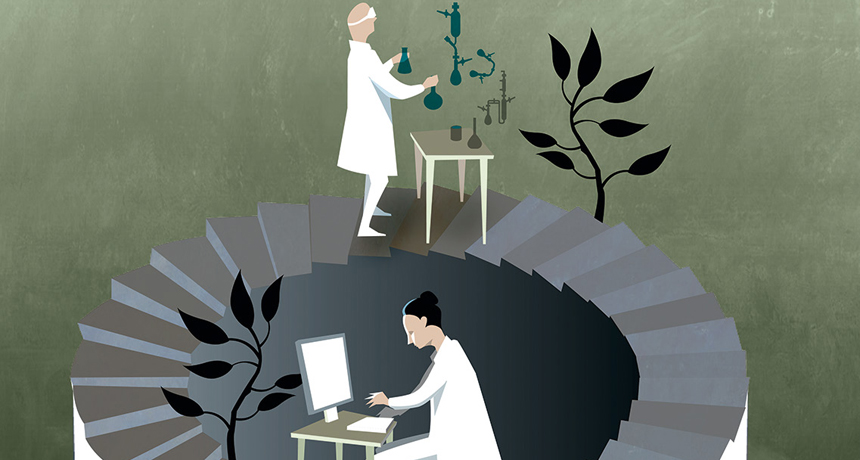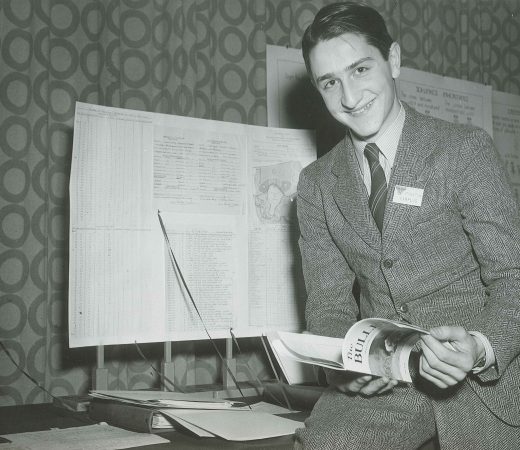Cyberspace chemistry earns a Nobel
By Meghan Rosen and Beth Mole

Chemists today experiment just as much on their computers as they do in their labs. The efforts of the men who won the 2013 Nobel Prize in chemistry made computer predictions of chemical reactions a good gauge of what can happen in nature. Still, those theoretical (computer) predictions must be confirmed by real experiments to verify how the world works — at least on the scale of atoms and molecules.
Nobel Foundation
Research that used computers to model the activity of chemicals as they react rapidly and in complex ways has won the 2013 Nobel Prize in chemistry.
Martin Karplus of Harvard University and the University of Strasbourg, Michael Levitt of Stanford University and Arieh Warshel of the University of Southern California learned they had won Oct. 9. A representative of the Royal Swedish Academy of Sciences in Stockholm called each of them to share the exciting news. At a ceremony on Dec. 10, each man will receive a medal and share the cash prize equal to slightly more than $1.24 million.
Often, a Nobel Prize will be shared by people who work in the same field, but never with each other. In this instance, all three men have at times worked with one of the others.

The achievements that led to their new award are difficult to explain. Basically, the scientists figured out how to use computer programs to map the way that atoms and molecules interact as they undergo ultrafast chemical reactions. (A molecule is a group of atoms that represents the smallest possible amount of some chemical.) To make these computer programs, the scientists had to marry the power of quantum physics with the relatively simple computing demands of classical physics. Termed physical chemistry, this work uses the techniques and theories of physics to study chemical systems.
What the three men achieved led to techniques that now help chemists predict the outcomes of a wide range of chemical reactions. These include those reactions that underlie photosynthesis in plants and the docking of drugs into molecules within the body. These predictive analyses, based on math performed in computers, are called theoretical science.
“We save a lot of money, we save a lot of time and we save a lot of effort by doing the theoretical work first,” explains Sven Lidin. An inorganic chemist at Lund University in Sweden, he chaired the Nobel committee that selected this year’s award recipients in chemistry. Once theoretical science predicts what should occur, scientists can perform experiments or make observations of nature to test how good those predictions were. If they proved very reliable, then future predictions of similar reactions will be easier to accept without lots of follow-up tests.
A phone call wakened Warshel at 3:00 a.m. in California to tell him he would share this year’s Nobel. Despite getting so little sleep, Warshel reassured people that day that he felt “extremely well.”
His path to the prize began in 1968. That’s when Warshel was a graduate student at the Weizmann Institute of Science in Rehovot, Israel. There, he worked with Levitt, a visiting scholar who had just received a college degree in chemistry. The pair created some of the first computer simulations of the energy states of molecules. Those early simulations involved only a few atoms.
Later simulations became more complex. “They came up with a really simple and really fast way to calculate the energy of a system that contains many, many atoms,” notes Kenneth Merz. He’s a computational chemist at Michigan State University in East Lansing.
In the early 1970s, Warshel worked with Karplus at Harvard. Karplus had already made major strides in using quantum physics to start describing how molecules react. Together the two scientists devised a method to study the relaxed and excited energy states of molecules. The atoms they studied would all lie in a flat plane.
Their work “was the first time anyone ever merged the quantum and classical worlds in chemistry,” says Gunnar Karlström. A theoretical chemist at Lund University in Sweden, he was alsio a member of the chemistry Nobel committee.
Warshel and Levitt would soon merge the two types of physics to build computer simulations to study a chemical reaction involving lysozyme. It’s an enzyme in tears and saliva. One of its roles in the body: to chop through bacterial cell walls.
Work in Karplus’s lab went on to simulate how proteins fold and wiggle.That theoretical work helped scientists realize how dynamic proteins are, Merz says. “We think about proteins now as always moving and doing things, not just bricks that are coursing through our veins or in our cells.”
The new Nobel Prize recipients pioneered an easier way to study complicated reactions. What they developed has already helped chemists design drugs, predict how ions move through a channel and understand how certain enzymes react with their targets. “I think nearly everybody that works in the area of theoretical and computational chemistry have for sure used the methods and programs developed by the three that won the prize,” says chemist David Clary of the University of Oxford, England.
At least one of the new prize winners began his science career early. At 16, Martin Karplus picked up one of the two top prizes at the 1947 Westinghouse Science Talent Search. This competition was created and is still run by Society for Science & the Public. (SSP is the parent organization of Science News for Students.) As with the Nobel, Karplus shared the top award, but didn’t need to share the money. He got the full STS scholarship, worth $2,400. And the nature of his research back then: ornithology — the study of birds.
Power Words
chemical reaction A process that involves rearrangement of the molecules or structure of a substance, as opposed to a change in physical form.
chemistry A science that deals with the composition, structure and properties of substances and with the changes that they go through. Chemists use this knowledge to study unfamiliar substances, to reproduce large quantities of useful substances, or to design and create new and useful substances.
classical physics An explanation of the nature and properties of matter and energy using descriptions such as Newton’s laws of motion. It’s an alternative to quantum physics in explaining the motions and behavior of matter.
computational chemistryA branch of chemistry that uses computer programs that describe mathematically what’s known about the operations of atoms and molecules to predict or calculate the properties of other molecules or interactions between molecules.
graduate student Someone working toward an advanced degree by taking classes and performing research. This work is done after the student has already graduated from college (usually with a four-year degree).
molecule An electrically neutral group of atoms that represents the smallest possible amount of a chemical compound. Molecules can be made of single types of atoms or of different types. For example, the oxygen in the air is made of two oxygen atoms (O2), but water is made of two hydrogen atoms and one oxygen atom (H2O).
physical chemistryThe area of chemistry that uses the techniques and theories of physics to study chemical systems.
physicsThe scientific study of the nature and properties of matter and energy.
quantum theory A way to describe the operation of matter and energy at the level of atoms. It is based on an interpretation that at this scale, energy and matter can be thought to behave as both particles and waves. The idea is that on this very tiny scale, matter and energy are made up of what scientists refer to as quanta — miniscule amounts of electromagnetic energy.
quantum physics A branch of physics that uses quantum theory to explain or predict how a physical system will operate on the scale of atoms.
theoretical An adjective for an analysis or assessment of something that based on pre-existing knowledge of how things behave. It is not based on experimental trials. Theoretical research tends to use math — usually performed by computers — to predict how or what will occur for some specified series of conditions. Experimental testing or observations of natural systems will then be needed to confirm what had been predicted







